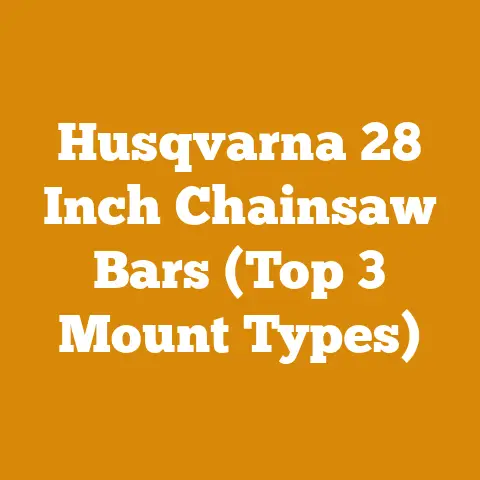Bent Chainsaw Bar Repair (3 Pro Tips Every Logger Should Know)
Bent Chainsaw Bar Repair: 3 Pro Tips Every Logger Should Know (and How to Avoid the Bend in the First Place!)
(Image: A split-screen image. On one side, a severely bent and damaged chainsaw bar. On the other side, a well-maintained, straight bar cutting through wood smoothly.)
I’ve seen my fair share of bent chainsaw bars in my time.
From greenhorns who’ve squeezed the bar in a bind to seasoned loggers pushing their equipment past its limit, a bent bar is a common (and frustrating) sight.
It’s not just an inconvenience; it can impact your cutting efficiency, shorten the life of your chain, and even be a safety hazard.
Think of it like driving a car with misaligned wheels – it pulls, it vibrates, and eventually, something breaks.
Understanding the Culprits: Why Chainsaw Bars Bend
Before we get into fixing a bent chainsaw bar, it’s crucial to understand why it happens.
Knowing the root cause can significantly reduce the chances of it happening again.
In my experience, here are the most common culprits:
1. Pinching the Bar: The No. 1 Offender
This is the single biggest reason chainsaw bars bend.
When the wood closes in on the bar during a cut, it creates immense pressure.
If you force the saw, the bar can easily bend, especially if it’s a thinner or lower-quality bar.
- How it Happens: Typically occurs when felling trees, bucking large logs, or cutting wood under tension.
- Prevention: Use wedges to keep the cut open, especially when felling.
Also, learn proper cutting techniques that minimize the risk of pinching. - The Cost: A new high-quality bar can set you back anywhere from $50 to $200, depending on the length and brand.
But the real cost is the lost time and productivity.
Think about it – if you’re making $500 a day logging, a bent bar can easily cost you a day’s wages.
2. Overheating: The Silent Killer
Excessive heat weakens the steel in the bar, making it more susceptible to bending.
This usually happens when the chain is dull, the bar is not properly lubricated, or you’re forcing the saw through the wood.
- How it Happens: Prolonged cutting with a dull chain, inadequate bar oil, or pushing the saw too hard.
- Prevention: Keep your chain sharp, use the correct type and amount of bar oil, and let the saw do the work.
Regular cleaning of the bar and chain is also essential. - The Cost: Overheating not only bends the bar but also damages the chain and potentially the saw itself.
A new chain can cost between $20 and $80, and a major saw repair can easily run into hundreds of dollars.
Neglecting maintenance is a false economy.
3. Improper Chain Tension: Too Tight, Too Loose
Incorrect chain tension puts undue stress on the bar.
A chain that’s too tight can overheat and cause the bar to bend, while a chain that’s too loose can jump off the bar, leading to damage and potential injury.
- How it Happens: Failing to adjust the chain tension regularly, especially when the chain is new or after prolonged use.
- Prevention: Check and adjust the chain tension before each use and periodically during cutting.
The chain should be snug but still able to be pulled slightly away from the bar. - The Cost: A loose chain can damage the sprocket and clutch, leading to expensive repairs.
A tight chain can cause premature wear on the bar and chain, shortening their lifespan.
The cost of neglect adds up quickly.
4. Using the Wrong Bar: Size Matters
Using a bar that’s too long for your saw, or a bar that’s not designed for the type of cutting you’re doing, can put excessive stress on it.
- How it Happens: Trying to cut trees that are too large for the saw’s capabilities, or using a bar designed for softwood on hardwoods.
- Prevention: Always use the correct bar length and type for your saw and the type of wood you’re cutting.
Consult your saw’s manual for recommendations. - The Cost: Using the wrong bar can damage the saw’s engine and transmission, leading to costly repairs or even replacement.
It’s an investment to get the right equipment for the job.
5. Accidental Damage: The Unforeseen
Sometimes, despite your best efforts, accidents happen.
Dropping the saw, hitting a rock or nail in the wood, or even just storing the saw improperly can damage the bar.
- How it Happens: Dropping the saw, hitting foreign objects in the wood, or storing the saw without a bar cover.
- Prevention: Handle the saw with care, always inspect the wood for foreign objects before cutting, and store the saw properly with a bar cover.
- The Cost: Repairing or replacing a bar damaged by an accident can be expensive, not to mention the potential for injury.
Safety is always the first priority.
Pro Tip #1: Assessing the Damage – Is Repair Even Possible?
Okay, so your bar is bent.
Before you start hammering away, let’s assess the damage.
Not all bent bars are salvageable.
Sometimes, the metal is too fatigued or the bend is too severe.
Trying to repair a bar that’s beyond saving can be a waste of time and effort, and it could even be dangerous.
The Visual Inspection: What to Look For
- Severity of the Bend: A slight bend near the tip is often repairable.
A severe bend, especially in the middle of the bar, is usually a sign that the bar is too damaged to repair safely. - Cracks or Stress Fractures: Carefully inspect the bar for any cracks or stress fractures.
These are signs that the metal has been weakened and the bar should not be repaired. - Twisting: If the bar is twisted, it’s generally not repairable.
Twisting indicates that the metal has been severely deformed. - De-lamination: Check for any signs of the bar separating, especially around the nose.
This is a sign of severe damage and the bar should not be repaired.
The “Straight Edge” Test: A Simple Diagnostic
A simple way to assess the severity of the bend is to lay the bar on a flat surface and use a straight edge (like a metal ruler or another straight bar) to check for gaps.
- How to: Place the bar on a flat surface and lay the straight edge along the length of the bar.
Look for any gaps between the bar and the straight edge. - What it Means: Small gaps (less than 1/8 inch) indicate a minor bend that is likely repairable.
Larger gaps indicate a more severe bend that may not be repairable.
The “Gut Feeling” Test: Trust Your Instincts
Sometimes, you just have to trust your gut.
If the bar looks like it’s been through the wringer, or if you’re not comfortable attempting the repair, it’s best to err on the side of caution and replace it.
- My Experience: I remember one time, I tried to repair a bar that was clearly too damaged.
I spent hours hammering and filing, only to have the bar break on me the next day.
It was a waste of time and effort, and it could have been dangerous.
Now, I’m much more selective about which bars I try to repair.
Cost Analysis: Repair vs. Replace
Before you start the repair, consider the cost of your time and materials.
Is it really worth it to spend several hours trying to fix a bar when you could just buy a new one?
- Time Cost: How much is your time worth?
If you’re a professional logger, your time is valuable.
Spending hours repairing a bar could cost you more than just buying a new one. - Material Cost: You’ll need a hammer, a vise, files, and possibly a torch.
These tools can cost money, especially if you don’t already have them. - Replacement Cost: A new bar can cost anywhere from $50 to $200, depending on the length and brand.
Compare this to the cost of your time and materials to decide if repair is the best option.
Example: Let’s say you value your time at $50 per hour.
It will take you 2 hours to repair the bent bar, and you need to buy a new file for $10.
The total cost of the repair is $110.
If a new bar costs $100, it’s more cost-effective to just buy a new one.
Pro Tip #2: The Gentle Art of Straightening – Techniques That Work
So, you’ve assessed the damage and decided that the bar is worth repairing.
Now it’s time to get to work.
The key to straightening a bent chainsaw bar is to be gentle and patient.
Forcing the bar can cause it to crack or weaken, making it even more dangerous.
The Vise and Hammer Method: A Classic Approach
This is the most common method for straightening a bent chainsaw bar.
It involves using a vise to hold the bar securely and a hammer to gently tap it back into shape.
- Tools You’ll Need:
- Vise: A sturdy vise is essential for holding the bar securely.
- Hammer: A ball-peen hammer is ideal for this task.
- Soft Metal Punch or Drift: This will protect the bar from being damaged by the hammer.
- Files: For smoothing out any rough edges after straightening.
- Safety Glasses: Always wear safety glasses when working with metal.
- Step-by-Step Guide:
- Secure the Bar: Place the bent section of the bar in the vise, making sure it’s held securely but not too tightly.
- Protect the Bar: Place the soft metal punch or drift between the hammer and the bar to prevent damage.
- Gently Tap: Use the hammer to gently tap the bar back into shape.
Work slowly and carefully, and avoid hitting the bar too hard. - Check Your Progress: Periodically remove the bar from the vise and check your progress with a straight edge.
- Repeat as Needed: Repeat steps 1-4 until the bar is straight.
- File Any Rough Edges: Use a file to smooth out any rough edges or burrs on the bar.
The Heat and Bend Method: For More Stubborn Bends
For more severe bends, you may need to use heat to make the metal more pliable.
However, be very careful when using heat, as it can weaken the metal if done improperly.
- Tools You’ll Need:
- Vise: A sturdy vise is essential for holding the bar securely.
- Propane Torch: A propane torch is ideal for heating the bar.
- Hammer: A ball-peen hammer is ideal for this task.
- Soft Metal Punch or Drift: This will protect the bar from being damaged by the hammer.
- Files: For smoothing out any rough edges after straightening.
- Safety Glasses: Always wear safety glasses when working with metal.
- Gloves: Wear heat-resistant gloves to protect your hands.
- Step-by-Step Guide:
- Secure the Bar: Place the bent section of the bar in the vise, making sure it’s held securely but not too tightly.
- Heat the Bend: Use the propane torch to heat the bent section of the bar.
Heat the metal evenly, and avoid overheating it.
You want the metal to be red-hot, but not white-hot. - Protect the Bar: Place the soft metal punch or drift between the hammer and the bar to prevent damage.
- Gently Tap: Use the hammer to gently tap the bar back into shape.
Work slowly and carefully, and avoid hitting the bar too hard. - Check Your Progress: Periodically remove the bar from the vise and check your progress with a straight edge.
- Repeat as Needed: Repeat steps 2-5 until the bar is straight.
- File Any Rough Edges: Use a file to smooth out any rough edges or burrs on the bar.
- Let it Cool Slowly: Allow the bar to cool slowly in the air.
Do not quench it with water, as this can weaken the metal.
Important Safety Note: When using heat, be sure to work in a well-ventilated area and wear appropriate safety gear, including safety glasses and gloves.
Tips for Success: Avoiding Common Mistakes
- Don’t Overheat: Overheating the bar can weaken the metal and make it more prone to bending in the future.
- Don’t Force It: Forcing the bar can cause it to crack or break.
Work slowly and gently. - Check Your Progress Regularly: Use a straight edge to check your progress frequently.
This will help you avoid over-correcting the bend. - Don’t Be Afraid to Stop: If the bar is too damaged to repair, don’t waste your time trying to fix it.
It’s better to just buy a new one.
Cost Breakdown: The True Cost of Repair
While repairing a bent bar can save you money in the short term, it’s important to consider the long-term costs.
- Labor Cost: How much is your time worth?
If you’re a professional logger, your time is valuable.
Spending hours repairing a bar could cost you more than just buying a new one. - Material Cost: You’ll need a hammer, a vise, files, and possibly a torch.
These tools can cost money, especially if you don’t already have them. - Reduced Bar Life: A repaired bar is likely to be weaker than a new bar, and it may not last as long.
This means you’ll have to replace it sooner, which will cost you more money in the long run. - Potential for Injury: Repairing a bent bar can be dangerous.
If you’re not careful, you could injure yourself.
Example: Let’s say you value your time at $50 per hour.
It will take you 2 hours to repair the bent bar, and you need to buy a new file for $10.
The total cost of the repair is $110.
However, the repaired bar is only likely to last half as long as a new bar.
If a new bar costs $100 and lasts for 2 years, the cost per year is $50.
The repaired bar will cost you $110 and only last for 1 year, so the cost per year is $110.
In this case, it’s actually more cost-effective to buy a new bar.
Pro Tip #3: Maintaining Your Bar – Prevention is the Best Medicine
The best way to deal with a bent chainsaw bar is to prevent it from bending in the first place.
Proper maintenance and care can significantly extend the life of your bar and save you money in the long run.
Regular Cleaning: A Simple but Effective Habit
Keeping your bar clean is essential for preventing overheating and premature wear.
Sawdust and pitch can build up in the bar groove and around the sprocket, restricting oil flow and causing the bar to overheat.
- How to Clean:
- Remove the bar and chain from the saw.
- Use a scraper or screwdriver to clean out the bar groove.
- Use a wire brush to clean the sprocket and the bar rails.
- Wipe the bar clean with a rag.
- Frequency: Clean your bar after each use, or at least once a day if you’re using the saw frequently.
Proper Lubrication: The Lifeblood of Your Bar
Adequate lubrication is crucial for preventing overheating and reducing friction between the bar and chain.
- Use the Right Oil: Use a high-quality bar and chain oil that is specifically designed for chainsaws.
Avoid using motor oil or other types of oil, as they may not provide adequate lubrication. - Check the Oil Level: Check the oil level in the saw’s oil reservoir before each use and refill as needed.
- Adjust the Oiler: Adjust the saw’s oiler to provide adequate lubrication.
The amount of oil needed will vary depending on the type of wood you’re cutting and the ambient temperature. - Clean the Oiler: Periodically clean the saw’s oiler to ensure that it is functioning properly.
Industry Data: Studies have shown that proper lubrication can extend the life of a chainsaw bar by up to 50%.
Chain Maintenance: A Sharp Chain is a Happy Chain (and Bar)
A dull chain puts extra stress on the bar, causing it to overheat and bend.
Keeping your chain sharp is essential for preventing bar damage.
- Sharpen Regularly: Sharpen your chain regularly using a chainsaw file or a chain grinder.
- Check Chain Tension: Check the chain tension before each use and adjust as needed.
A chain that’s too tight can overheat and bend the bar, while a chain that’s too loose can jump off the bar and cause damage. - Replace Worn Chains: Replace your chain when it becomes worn or damaged.
A worn chain can damage the bar and reduce cutting efficiency.
Proper Storage: Protecting Your Investment
Storing your chainsaw properly can help prevent damage to the bar and other components.
- Use a Bar Cover: Always use a bar cover when storing your chainsaw.
This will protect the bar from damage and prevent it from getting dirty. - Store in a Dry Place: Store your chainsaw in a dry place to prevent rust and corrosion.
- Loosen Chain Tension: Loosen the chain tension before storing the saw to prevent the bar from bending.
Cost Savings: The Cumulative Effect of Good Maintenance
The cost of maintaining your chainsaw bar is minimal compared to the cost of replacing it.
By following these simple tips, you can extend the life of your bar and save money in the long run.
- Reduced Replacement Costs: By preventing bar damage, you can avoid the cost of replacing the bar.
- Increased Cutting Efficiency: A well-maintained bar and chain will cut more efficiently, saving you time and fuel.
- Reduced Downtime: By preventing bar damage, you can avoid downtime due to repairs.
- Improved Safety: A well-maintained chainsaw is safer to use than a poorly maintained one.
Example: Let’s say you spend $20 per year on bar and chain oil, $10 per year on chainsaw files, and $10 per year on bar covers.
The total cost of maintaining your chainsaw bar is $40 per year.
However, by maintaining your bar, you can extend its life by 5 years.
If a new bar costs $100, you’ll save $60 by maintaining your bar.
Real-World Cost Analysis: A Case Study
To illustrate the real-world cost impact of bent chainsaw bars, let’s consider a case study of a small-scale logging operation in the Pacific Northwest.
The Scenario:
- A three-person logging crew harvests timber on private land.
- They use two chainsaws daily, each with a 20-inch bar.
- They typically harvest 5,000 board feet of timber per day, selling it for $0.50 per board foot, generating $2,500 in revenue.
- Each crew member earns $25 per hour.
The Impact of a Bent Bar:
- Scenario 1: No Bent Bars (Ideal Situation):
- The crew works efficiently, maintaining their equipment diligently.
- Daily revenue: $2,500
- Labor cost (3 crew members x $25/hour x 8 hours): $600
- Other operating costs (fuel, maintenance): $200
- Net daily profit: $1,700
- Scenario 2: One Bent Bar per Month:
- Each bent bar requires 2 hours of repair time (costing $50 per hour of labor).
- Downtime reduces daily harvest by 500 board feet (loss of $250 in revenue).
- Cost of new bar (assuming repair is not feasible): $100
- Total cost per bent bar incident: $250 (lost revenue) + $100 (labor) + $100 (new bar) = $450
- Monthly cost due to bent bars: $450
- Reduced monthly profit: $450
- Scenario 3: Two Bent Bars per Month (Neglect and Poor Technique):
- The crew experiences frequent bent bars due to poor cutting techniques and lack of maintenance.
- Each bent bar incident costs $450 (as calculated above).
- Monthly cost due to bent bars: $900
- Reduced monthly profit: $900
The Numbers Speak Volumes:
As you can see, the cost of bent chainsaw bars can significantly impact the profitability of a logging operation.
In this case study, neglecting maintenance and using poor cutting techniques can reduce monthly profits by up to $900.
The Takeaway:
Investing in proper maintenance and training can save money in the long run by preventing bent bars and other equipment failures.
There are many other hidden costs that can eat into your profits.
Increased Fuel Consumption: A Dull Chain’s Thirsty Nature
A dull chain forces the saw to work harder, which increases fuel consumption.
This can add up over time, especially if you’re using the saw frequently.
- Data: Studies have shown that a dull chain can increase fuel consumption by up to 20%.
- Cost Impact: If you’re spending $100 per week on fuel, a 20% increase will cost you an extra $20 per week, or $1,040 per year.
Premature Wear on Other Components: The Domino Effect
A bent bar or dull chain can put extra stress on other components of the saw, such as the engine, clutch, and sprocket.
This can lead to premature wear and expensive repairs.
- Example: A bent bar can cause the chain to wear unevenly, which can damage the sprocket.
A damaged sprocket can then cause the chain to jump off the bar, which can damage the engine. - Cost Impact: A major saw repair can easily cost hundreds of dollars.
Increased Risk of Accidents: Safety First, Always
A bent bar or dull chain can make the saw more difficult to control, which increases the risk of accidents.
- Data: Chainsaw accidents are a leading cause of injury in the logging industry.
- Cost Impact: A chainsaw accident can result in serious injuries, medical expenses, and lost work time.
It can also lead to increased insurance premiums.
Reduced Productivity: Time is Money
A bent bar or dull chain can reduce cutting efficiency, which reduces productivity.
- Example: If it takes you 2 hours to cut a cord of wood with a dull chain, it might only take you 1.5 hours with a sharp chain.
- Cost Impact: If you’re making $50 per hour, the extra 30 minutes it takes to cut a cord of wood with a dull chain will cost you $25.
The Bottom Line: Prevention is Key
The costs of equipment neglect can add up quickly.
By investing in proper maintenance and care, you can avoid these hidden costs and save money in the long run.
Actionable Takeaways: Your Next Steps
Okay, you’ve made it to the end.
Here’s a recap of the actionable steps you can take to prevent bent chainsaw bars and save money in the process:
- Assess Damage Carefully: Before attempting a repair, thoroughly inspect the bar for cracks, twists, or severe bends.
If in doubt, replace it. - Master the Gentle Art of Straightening: Use a vise and hammer, or heat and bend techniques, with patience and caution.
- Prioritize Maintenance: Clean your bar regularly, use proper lubrication, keep your chain sharp, and store your saw properly.
- Factor in the True Cost: Consider the cost of your time, materials, and potential for reduced bar life when deciding whether to repair or replace a bent bar.
- Invest in Training: Proper cutting techniques and equipment handling skills are essential for preventing bar damage and other accidents.
Final Thoughts: A Logger’s Perspective
After years of working with chainsaws, I’ve learned that the best way to save money is to take care of your equipment.
A little bit of prevention can go a long way.
Remember, your chainsaw is an investment.
Treat it well, and it will serve you for years to come.
And if you do happen to bend a bar, don’t be afraid to try to repair it.
But always prioritize safety and don’t be afraid to replace it if it’s too damaged.
Happy cutting!






